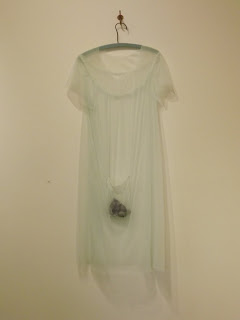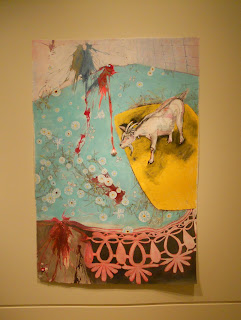The show that I attended was the Saranac at the Falls. Artworks were made by many local artists. Our very own Katie Creyts and Scott Kolbo had some of their art displayed there. This show also featured the work of Dani Pavlic, Nancy Hathaway, Jeff Huston, Christ Tyllia, Cori McWiliams, Lisa Nappa, Shelly Williams, Dan McCann, Carrie Scozzaro, Lance Sinnema, Jen Erickson, Roger Ralston, Margo Casstevens, Kurt Madison, and Matt Boland. I was not familiar with any of these other artists.
The gallery consisted of many varied works. There were a number of art styles including painting, drawing, sculpture, and videos. The materials used were charcoal, wood, metal, ink, paper, digital print, ceramic, copper, gesso, glaze, oil, graphite, aluminum, panel, glass, rice paper, rubber, and nails. Most of the art was mixed media. So this was a very di
I think bringing such a unique show to the Falls gives the students there, from other schools (like Whitworth), and local artists a chance to explore many styles of art. Because the gallery itself is small, artistic interactions are more likely to spark.
The piece that I chose to study more closely was Lullaby by Katie Creyts. After studying the piece, interviewing Katie, and reading her artist statement I got a pretty good idea of what her work is all about. Her main focus is fairytales and the real world, conversely. Another theme of hers is femininity. She uses a light, transparent dress as the main focus for her sculpture. I assumed there were rocks in the front pocket until I interviewed Katie and found out that they were actually mice made of glass. That is the effect she hopes to produce, it’s about discovering little things like that. The fact that no one is wearing the dress gives room for the viewer to create their own story. The dress basically serves as springboard for making fantasy.
The materials used for this piece are simple, mesh cloth and glass. In terms of physical and visual mass, they balance each other out. This was the way I originally interpreted the work. I thought it was just two types of materials p
Personally, I find looking at Katie’s artwork very nostalgic. All the stories the sculptures provoke the viewer to conceive remind me of cartoons that you watch as a kid. It really makes you ponder about your childhood and evokes some long-forgotten memories. I don’t think I’ve ever seen art such as this. Does the piece Lullaby remind you of some part of your childhood? If not, I suggest looking at other sculptures by Katie Creyts.
Work Cited
Creyts, Katie. "Interview with Katie Creyts." Personal interview. 18 Oct. 2011.
"Katie Creyts Artist Statement." Katie Creyts. Web. 24 Oct. 2011.





























